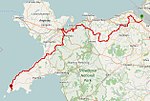Ysgol Treffynnon
Secondary schools in Flintshire
Ysgol Treffynnon (formerly Holywell High School) is an 11–16 mixed, English-medium, community secondary school in Holywell, Flintshire, Wales. Previously it was Holywell Grammar School. There were 2 buildings which made up the school; Lower and Upper. The Lower building catered for 11-13 year olds and the Upper building for 14-18 year olds and included the Sixth Form. The upper building was demolished in the mid-1990s to make way for a new housing development and the Lower building was remodelled to accommodate the whole school into one building.
Excerpt from the Wikipedia article Ysgol Treffynnon (License: CC BY-SA 3.0, Authors).Ysgol Treffynnon
Heol Y Brenin,
Geographical coordinates (GPS) Address Nearby Places Show on map
Geographical coordinates (GPS)
| Latitude | Longitude |
|---|---|
| N 53.27732 ° | E -3.21753 ° |
Address
Heol Y Brenin
Heol Y Brenin
CH8 7AR , Holywell
Wales, United Kingdom
Open on Google Maps






